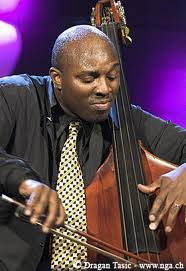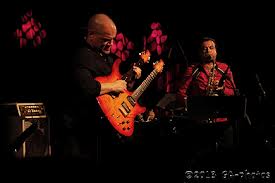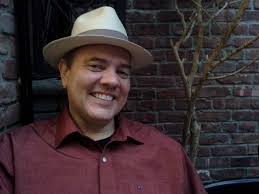Second week of Jazz Appreciation Month:
-
- pianist Edsel Gomez talked  in my NYU “World Music” class of working with Malian musicians on Dee Dee Bridgewater’s extrafine Red Earth project;
- Ralph Simon, producer of late lamented Postcard Records and soprano saxist, had a private with me consultation on resuming jazz activities;
- Bassist Charnett Moffett at Birdland, midtown, for a showcase of The Bridge, his new solo recording on Motema Music, for which I wrote liner notes;
- Immediately thereafter: Â Gamak (Rudresh Mahanthappa, alto sax; Dave Fiuczynski, electric guitars; Francois Mouton, upright bass; Dan Weiss, traps kit) at le Poisson Rouge on the Village;
- Then 6 train uptown to Café Carlyle for trumpeter/singer Bria Skonburg‘s set with quartet backing of Sean Cronin, upright bass & vocals; Dalton Ridenhour, piano;  Darrian Douglas, drums;
- Sampled some new recordings: Ross Hammond Quartet Cathedrals and John Ehlis Ensemble Along the Way, among the worthies;
- Consulted on Jazz Hero parties in Austin for Dr. James Polk, blues jazz pianist; Schenectady for Tim Coakley, veteran Sat. night radio jock, area drummer  and copy editor; Philadelphia for Jim Miller, drummer/educator and one-man record label Dreambox Media; San Francisco bay area for Sunny Buxton (KCSM, ex-Pearl’s jazz club) and Randall Kline (director SFJazz);
- Organized the Jazz Journalists Assoc’s Int’l Jazz Day party, co-hosted by the Louis Armstrong House Museum — on April 30, 2 pm at the Langston Hughes Community Library and Cultural Center, Corona, Queens — unveiling newly discovered Louis Armstrong tapes from 1961, Freedomland Amusement Park, the Bronx with discussion by archivist Ricky Riccardi and dean of jazz journalists Dan Morgenstern.
Edsel Gomez, who I’d run into by chance at lunch during JazzApril week 1, spoke candidly to my class about the challenges and rewards of music-directing an ensemble mixing traditionalist Mali griots with the American pros of hot singer Dee Dee Bridgewater’s band. He said the Africans were meticulous preservationists; that it had taken him several days of rehearsal to win their trust; of how he learned to use the piano to extend the harmonic limits of their mostly pentatonic scales of their koras and balafons, and of the extreme wealth he’d seen touring North Africa, juxtaposed with widespread poverty. A superb pianist, Edsel made the funky instrument in my classroom ring orchestrally through his version of “Afro Blue,” written by Mongo Santamaria and sung by Dee Dee on her Red Earth tour (which lasted on and off for three years). He mentioned his fascinating background, too: Growing up in Puerto Rico playing in salsa bands, arriving at Berklee School of Music when he was 17, away from home the first time, speaking mostly English suddenly, having to make his way; 10 years living in Brazil, then his return to the U.S. His next gigs are in the Chick Corea Festival scheduled for May at Jazz at Lincoln Center.
I annotated at least a couple of the albums Ralph Simon organized and co-starred on in the ’90s (notably Magic Club: Music for the Millenium, with collaborators including Paul Bley, Gary Peacock, Julian Priester, Bruce Ditmas, Alan Pasqua). Upon the label’s sale and evident demise several years ago, he retrained himself as a family therapist, but now he’s got the jazz itch again. Simon believes there’s talent still to be encouraged, recorded and enjoyed from the jazz era Ken Burns skipped over (that would be from the death of Coltrane, 1967, to the rise of Jazz at Lincoln Center, circa 1987) and is eager to discover some of the new talents I mentioned who have emerged while he’s been engaged elsewhere. Simon’s considering, plotting, gathering forces. . .and I told him times are tough for selling jazz albums, but yes, we want good new ones. . .
Holding a crowd playing solo bass ain’t easy. Tell it to Charnett Moffett — who has worked with  Wynton Marsalis, Ornette Coleman, Stanley Jordan and McCoy Tyner, among others — has his program down and his chops way up for the widely-drawn repertoire he plays. Completely exposed in this setting, he demonstrated a virtuosic manner of weaving the rhythm, melody and harmonic extensions of songs by Sting, the Beatles, Monk, Mingus, Ellington et al. into performances that throbbed and glistened. The crowd seemed to like it; I did, too, otherwise I wouldn’t have written the notes or introduced him from the bandstand.
Wynton Marsalis, Ornette Coleman, Stanley Jordan and McCoy Tyner, among others — has his program down and his chops way up for the widely-drawn repertoire he plays. Completely exposed in this setting, he demonstrated a virtuosic manner of weaving the rhythm, melody and harmonic extensions of songs by Sting, the Beatles, Monk, Mingus, Ellington et al. into performances that throbbed and glistened. The crowd seemed to like it; I did, too, otherwise I wouldn’t have written the notes or introduced him from the bandstand.
Wow is the right term of the Mahanthappa-Fiuczynski front line — they are two of the fiercest lyrical hard-blowers now. Fuze plays double-necked guitars, sliding microtonally around the unfretted one, picking unbelievably fast and intricate figures with rock-star alacrity on the fretted. Rudresh pours his breath through his alto in impossibly long lines, with exquisite sighing inflections as well as a righteous burn. Mouton and Weiss both dug in, too. My colleague Bill Milkowski, sitting with me, said ‘They sound like Prime Time,” and I answered, “Prime Time from Hawaii,” due to the slack-key/surf’s up qualities; there were nods to the Grateful Dead and Mahavishnu Orchestra, not to mention Fuze’s old outfit the Screaming Headless Torsos. Wow they were smokin’. I’d go again.
sound like Prime Time,” and I answered, “Prime Time from Hawaii,” due to the slack-key/surf’s up qualities; there were nods to the Grateful Dead and Mahavishnu Orchestra, not to mention Fuze’s old outfit the Screaming Headless Torsos. Wow they were smokin’. I’d go again.
The Jazz Journalists Association having nominated Bria Skonberg for the 2013 Up and Coming Artist Award, I wanted to check her out, and I’m glad I did. She’s a bright young woman from British Columbia who sings and plays trumpet, shares patter with her bassist and occasional vocal partner Cronin, and has put together a program called “Brass and Belles” that revives Valaida Snow’s “High Hat, Trumpet and Rhythm” as well as “Let’s Call the Whole Thing Off” (a la Ella Fitzgerald and Louis Armstrong) and “September Song” (referring to Sarah Vaughan with Clifford Brown). These selections are lively, and if some of her horn playing seems more studied than spontaneous, when she loses herself in a giddy version of “Old Black Magic” (from Keely Smith with Louis Prima), she wins grins. Pianist Ridenhour was at his best on a blues, and drummer Douglas is fresh to NYC from New Orleans, as one could hear from his backbeat.
I’ve received more than 50 cds potentially for review since April 1 (more than 100 since March 14), plus a couple of dozen links to music for downloading, and have sampled them spottily, which isn’t a good way to get into new music. The good way, without doubt, is to sit down, relaxed, and let the sounds roll over you. My present occupations make such quality time a rare luxury, but after previewing guitarist Hammond’s Cathedrals (with Vinny Golia on reeds and flute; Steuart Liebig, bass; Alex Cline, drums/percussion) and guitarist Ehlis’s Along the Way (quartets to septets with a strong cast, including John Tchicai on tenor sax for his last recording) I intend to get better acquainted with them.
And I’ll at least dip into new music by the big band Swingadelic (Toussaintville), guitarist Marc Ribot’s trio Ceramic Dog (Your Turn), guitariasts Gilad Hekselman (This Just In) and Philip Gibbs (with vocalist Mossa Bilder and Karl Berger on vibes, After the Storm), drummers Jaimeo Brown (Transcendence) and Kendrick Scott (Conviction), flutist Nicole Mitchell (Engraved in the Wind and Aquarius), pianists Peter Madsen (Soul of the Underground), Aaron Diehl (The Bespoke Man’s Narrative), Laszlo Gardony (Clarity), Uri Caine with Han Bennink (Sonic Boom), Edward Simon (Trio Live in New York at Jazz Standard), Steve Kuhn (The Vanguard Date) and Jacky Terrason (Gouache); trombonist Reut Regev (Exploring the Vibe), Quest (Circular Dreaming), pianist Eli Yamin with clarinetist Evan Christopher (Louie’s Dream for our Jazz Heroes), bassists Robert Hurst (Bob A Palindrome) and Joshua Abrams (Unknown Known), tenor saxist Norbert Stein (Pata on the Cadillac), alto saxist Miguel Zenón (Oye!!! Live in Puerto Rico), Monika Roscher Big Band (Failure in Wonderland), reedsman Ben Wendell with keyboardist Dan Tepfer (Small Constructions), singer Cécile McLorin Salvant (WomanChild), and many more (I’ll mention duo pianists Tommy Flanagan/Jaki Byard’s The Magic of 2, drummer Yoron Israel’s Visions, The Music of Stevie Wonder and drummer/percussionist Kahil El’Zabar Quartet’s What It Is! with the caveat that I wrote the liner notes for all three, so I’ve already devoted hours to studying — and enjoying — those productions).

